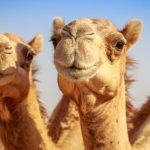 Music
Music  Music
Music  History
History 10 Less Than Jolly Events That Occurred on December 25
 Weird Stuff
Weird Stuff 10 Funny Ways That Researchers Overthink Christmas
 Politics
Politics 10 Political Scandals That Sent Crowds Into the Streets
 Weird Stuff
Weird Stuff Ten Bizarre Facts About The Doge Meme
 Our World
Our World 10 Ways Your Christmas Tree Is More Lit Than You Think
 Movies and TV
Movies and TV The 10 Coolest Stars to Set Sail on The Love Boat
 History
History 10 Things You Didn’t Know About the American National Anthem
 Technology
Technology Top 10 Everyday Tech Buzzwords That Hide a Darker Past
 Humans
Humans 10 Everyday Human Behaviors That Are Actually Survival Instincts
 Music
Music 10 Surprising Origin Stories of Your Favorite Holiday Songs
 History
History 10 Less Than Jolly Events That Occurred on December 25
 Weird Stuff
Weird Stuff 10 Funny Ways That Researchers Overthink Christmas
Who's Behind Listverse?

Jamie Frater
Head Editor
Jamie founded Listverse due to an insatiable desire to share fascinating, obscure, and bizarre facts. He has been a guest speaker on numerous national radio and television stations and is a five time published author.
More About Us Politics
Politics 10 Political Scandals That Sent Crowds Into the Streets
 Weird Stuff
Weird Stuff Ten Bizarre Facts About The Doge Meme
 Our World
Our World 10 Ways Your Christmas Tree Is More Lit Than You Think
 Movies and TV
Movies and TV The 10 Coolest Stars to Set Sail on The Love Boat
 History
History 10 Things You Didn’t Know About the American National Anthem
 Technology
Technology Top 10 Everyday Tech Buzzwords That Hide a Darker Past
 Humans
Humans 10 Everyday Human Behaviors That Are Actually Survival Instincts
Ten Things You Never Knew About American Vice Presidents
Much is made of the U.S. president. As it should be, right? Being the commander-in-chief of the United States is an important job that goes 24 hours a day, seven days a week, for either one four-year term or two—however long the American public decides that person has the ability and privilege of serving in office. So it makes sense that the public knows much about the president’s daily activities, political opinions, policy choices, and even his personal lifestyle.
But the vice president? There just isn’t as much interest there. Sure, the VP is only one heartbeat away from serving as the nation’s leader in the White House. And several vice presidents have had to step in and assume that leadership role in dire circumstances throughout the history of the United States. But for the most part, being VP means living in a parallel universe where fewer folks are focused on you despite your existence right behind the most powerful politician on the planet. Strange!
Well, let’s open up the world of the vice president a little bit today. In this list, we’ll take a look at ten interesting, unique, and unknown facts about past American vice presidents. You likely have never heard these stories about these understudies to the president. But they’ll shock and entertain you at the same time!
Related: Top 10 Presidential “Bad Boys”
10 Coining the Term “Veep”
If you’ve ever used the term “veep” to describe a vice president, you have Alben W. Barkley to thank. (And yes, Julia Louis-Dreyfus and her long-running HBO show by that very same name ought to thank Barkley for it, too.) Barkley was a longtime politician from Kentucky who had served the Bluegrass State for years in local and statewide offices. First elected to Congress in 1912, he carried on his duties from Washington with enough aplomb that other more powerful political figures took notice.
Enter Harry S. Truman, who tabbed Barkley to be his running mate for his post-war presidency. From 1949 to 1953, Alben W. Barkley served as the vice president to Truman as the commander tried to enact his agenda that saw post-war economic booms and Cold War beginnings. But that stuff is all boring. The good stuff comes from Barkley’s youngest grandson, who was just growing up when the Kentucky man took office with Truman.
The young boy didn’t care for Barkley’s official title, you see. Technically, the VP was to be referred to as “Mr. Vice President” in all contexts among colleagues. But those are a lot of syllables for a young mouth to work out. So the young boy had a suggestion for his grandpa. Instead of the official moniker, just go by “Veep,” a smoothly connected version of the initials “VP.” Barkley loved his grandson, loved the idea, and ran with it. And ever since, it’s become commonplace to call the vice president by that shortened nickname.[1]
9 Nearly in Charge
Adlai Stevenson was a longtime politician and public servant in the late 19th century who unsuccessfully ran for U.S. president. Even though voters didn’t want him in the White House, other leaders did. And when it came time for Grover Cleveland to campaign for (and win) the nation’s highest office at the very end of the 19th century, he chose Stevenson as his running mate. For a while, all was normal, with Cleveland in charge and Stevenson serving as his vice president.
Then, in 1893, Cleveland developed serious health issues. He was suffering from a cancerous tumor on his mouth and part of his jaw, and he needed immediate and risky surgery to remove the tumor and straighten out his well-being. Not wanting to tell anybody about it, Cleveland actually chose to have the surgery off-shore on a ship at anchor. The serious procedure was done in complete secret, and thankfully, it was a success. But Stevenson was on call the entire time and ready to step in as President should the worst occur. Fortunately for Cleveland and the nation—but unfortunately for Stevenson’s personal aspirations—that call never came.
Also, there’s an interesting and morbid footnote to Stevenson’s political career. You may recognize his name if you were around the middle part of the 20th century. That’s because he had a grandson with the same name: Adlai Ewing Stevenson II. The latter Stevenson was also a longtime politician. He served as the Governor of Illinois not long after World War II, then, just like his grandfather, had two failed runs for the White House—losing twice to Dwight D. Eisenhower—before finishing his career as America’s ambassador to the United Nations. History repeats and all that.
But that’s not the poignant part. The shocking story goes like this: In 1912, as a 12-year-old boy, the younger Adlai Stevenson accidentally shot and killed a 16-year-old friend. He had been demonstrating his rifle techniques when he mistakenly clipped the trigger on a gun he’d accidentally kept loaded for the drill. The ensuing blast killed a girl named Ruth Merwin and devastated the younger Stevenson.
For the next four decades, he never spoke about the incident. Then, in 1955, one of his aides told the politician about a young boy who had caused a similar accidental death. Stevenson wrote a letter of support to the boy’s mother, saying the child “must now live for two.” The younger Stevenson’s shocked friends realized that was his subtle and solitary take on the tragedy that ended his own youth. Chilling…[2]
8 Endless Apartment Alterations
Nelson Rockefeller was named Gerald Ford’s VP during a difficult time for the country. The scandalous end to the Richard Nixon administration wasn’t far from people’s minds, and Ford was dead-set on trying to steady the nation. So he chose Rockefeller to serve in his second-fiddle role. Rockefeller came from a very wealthy family—perhaps you’ve heard the name before, especially if you’ve ever been to New York City—and the unlikely VP used some of that wealth to compulsively construct, alter, and change around his NYC apartment for years… and years, and years.
Rockefeller lived in a co-op pad at 810 Fifth Avenue in a swanky part of Manhattan. He loved the place so much that he chose to buy out the floors above and below his home. With his wife at the time, Rockefeller used the three stories of prime NYC real estate to build an incredible 30-room triplex. Then, the two of them got divorced. So he gave her the top two floors and kept the bottom one for himself. That surely makes for awkward neighbors, doesn’t it?
The set-up wasn’t a problem for the unlikely VP, though, because he ended up buying the apartment next door to his new digs in time. He joined it with his one-floor apartment and made himself a bigger space. Then, when it came time to marry his second wife, they switched up their elevator habits and moved to the next-door unit’s lift full-time. That way, they didn’t have to worry about seeing Nelson’s ex-wife going upstairs to the floors above them. Ironically, Richard Nixon himself ended up buying an apartment on the very same block as Rockefeller in 1979. The now-former VP wasn’t able to make good with his new neighbor, though; Nelson died just weeks before Nixon’s purchase.[3]
7 Taking the Job by Force
Poor William Henry Harrison. He went to all the trouble of campaigning, forming alliances, and making strategic partnerships and all the backroom dealings that come with politics. Then, upon being elected to serve as president, he waltzed into the White House. Then, a month after that, he was dead. Just 31 days into his term in 1841, William Henry Harrison was felled by a sudden and severe illness and died in office.
At the time, John Tyler was his vice president. As Harrison lay dying in the White House, he was delirious and in great pain. However, he still could speak. And at one point late on the evening of his death, Harrison turned to his attending doctor—who he mistakenly assumed to be VP Tyler in his delirium—and said, “Sir, I wish you to understand the true principles of the government. I wish them carried out. I ask nothing more.”
Tyler took that suggestion to heart in a big way. He assumed the office of the presidency after Harrison passed away despite major qualms by other Washington leaders. None other than former President John Quincy Adams slammed Tyler for rising to the role of president, telling the public that the former VP’s push for power was “in direct violation both of the grammar and context of the Constitution.”
That strong speech didn’t move Tyler to back off, though. In fact, it only spurned him further on toward power. Even as his political party officially expelled him, Tyler continued his reign in the place of Harrison. He finished out Harrison’s term as president after having served the shortest vice president run in all of American history.
Then, to really drive the point home that he’d gone against the grain in Washington, Tyler returned to his native Virginia after the term and bought a plantation that he renamed Sherwood Forest. Citing Robin Hood as his inspiration for the name, Tyler reportedly wanted to honor his professional life as a “political outlaw.” That he indeed was—the vice president who pushed for power despite objections from nearly everyone else around him![4]
6 What’s in a (Nick)name?
Martin Van Buren served as Andrew Jackson’s second vice president from 1833-1837. The New York native had gotten to the second seat of government power in a very cunning way. By both charming his potential supporters and shrewdly defeating opponents in backroom deals and careful moves, Van Buren was notorious long before he reached the top. Look no further than his ample nicknames to learn why!
Friends and enemies alike took to referring to Van Buren as the “Little Magician” during his political career. Even before he became VP, he was called that for two reasons. First, at under 5’5″, he was relatively short for a man, even for that time in history. Second, he tended to make magic for himself and his own aspirations in his political career—often at the expense of others. Just ask John C. Calhoun, Jackson’s first VP, whom Van Buren pushed past to rise to the role in the president’s second term.
In 1837, Van Buren took the reins of the presidency for himself. By the time he commandeered the White House under his own direction after Jackson’s service, political opponents had taken to adding another nickname to Van Buren’s list: “the Fox.” But fate would have far worse consequences for The Fox than he ever expected. That year, a financial panic set off a marked economic depression. Van Buren struggled to steady the ship, and Americans across the land suffered for it. Three years later, in 1840, another economic crisis catapulted the country into even more financial turmoil.
Disgraced by the two crises and no real policy proclamations from Van Buren to stop them, the Democrats refused to re-nominate him for a second term in 1840. Suddenly, the “Little Magician” was being outfoxed by forces far bigger than himself. He tried to align with the upstart Free Soil Party for the nomination, but that didn’t turn into anything major, and his political career ended at the hands of Whig candidate William Henry Harrison. And on the way out the door, Van Buren earned himself one more nickname: Martin Van Ruin. Oops![5]
5 Midwestern Linguist Pioneer
Charles Curtis served as vice president under Herbert Hoover for the commander-in-chief’s first and only term, from 1929 to 1933. So, in other words, Curtis was the number two on the ticket for some of America’s very darkest years. And while Curtis himself has not been associated with the difficulties of the Great Depression nearly as much as Hoover—there are no Curtisvilles, after all, but only Hoovervilles—the former VP nevertheless made his own unique and interesting mark in history.
Curtis was born in Kansas Territory back in 1860. But what is most interesting and unique about him is his heritage. The future-VP-to-be was born three-eighths Native American. His ancestors were members of the Kaw people who lived in what is now Kansas for centuries. In fact, Curtis was so closely tied to his Native American heritage that he didn’t even speak English growing up! Before he reached adulthood, Charles Curtis spoke only French and Kansa—the historical language of the indigenous Kaw people.
It was only when he grew a bit older that he quickly picked up English and moved forward on his path into politics. That career led him to become both a congressman and a senator representing Kansas in the early 20th century. It even earned him a term as Senate Majority Leader prior to taking the VP nomination. And yes, in case you were wondering, Curtis was the first (and, thus far, only) Native American to serve as vice president in U.S. history.[6]
4 A Modern Global Legacy
While Charles Curtis may have been the first non-white person to serve as vice president of the United States, he isn’t the only one. As modern readers no doubt know, current President Joe Biden’s VP is the 49th and current politician to hold the role, and the second one of color to do so after Curtis! Plus, the former California Attorney General is the first African-American VP in American history and the first Asian-American veep to ever assume the role. A pioneer in many different respects!
She’s not just a pioneer, either, but also an American named for many worldly things. Her mother Shyamala is an Indian-American woman who wanted to honor her heritage when Kamala was born way back in 1964. So Shyamala chose the name “Kamala” for the baby. That’s the Sanskrit term for “lotus flower.” The name Kamalā is also a reference to the Indian goddess of wealth and good fortune. Most of us may know that goddess as “Lakshmi, but Kamalā is another name for the deity.
That’s not the only moniker move related to Harris’s birth and upbringing, though. The VP’s middle name is “Devi,” another Sanskrit word. This one is more general, though, and is most often translated simply into “goddess” in English. Either way, between the two names, Shyamala clearly had high hopes for her daughter upon her birth 58 years ago. And considering Kamala is where she is today, we’d say those hopes have certainly materialized![7]
3 Gerry’s Gerrymandering
Elbridge Gerry was briefly the VP for James Madison’s time in office before dying while serving in the second-in-line role in 1814. And while you have almost certainly never heard of Elbridge Gerry himself, you’ve likely talked about a modern-day issue that was given its name because of his shady past dealings! Before Gerry took on the VP role under Madison, he was the governor of Massachusetts, among other jobs. And he wasn’t afraid to put his finger on the so-called scale to keep himself in power.
One year, Gerry suggested his state-level party of Democratic-Republicans draw the Massachusetts Senate districts in such a way that would favor them in elections. They wanted to lock out the opposing Federalists from power in any way they could. And while the Federalists were likely going to mount a pretty significant campaign in a Senate run in the state, Gerry figured out a way to prevent it: by very, um, creatively re-outlining voting districts.
To be fair to Gerry, he was far from the first to redraw district maps with his own party’s power in mind. However, he was definitely the most brazen. He had his party draw one district in a weird, oblong-like shape. Hoping to cut out Federalists from too much sway in the state, the funny-looking district was to be ideal for his chicanery. Unfortunately for Gerry, critics noticed the strange map immediately. One compared it unfavorably to a salamander, and from there, history took hold. We now know this district drawing practice to be “gerrymandering” thanks to a combo of Gerry’s name and that salamander reference.[8]
2 Vice President of Pop
Charles Dawes served loyally as Calvin Coolidge’s vice president from 1925 to 1929. What should have been a resoundingly successful time for the United States turned into, well, hell on earth right after the end of Coolidge’s term, of course. For that reason, Coolidge’s memory within the minds of the American public is checkered—and Dawes’s role might as well be non-existent. It’s okay to admit you didn’t even know Charles Dawes existed until you read his name at the top of this paragraph!
But there is one fascinating thing about Dawes that no other VP can say: During his lifetime, he penned a pop song that eventually climbed to the top of the charts. In 1911, more than a decade before taking on Coolidge’s number two-man role, Dawes wrote a song called “Melody in A Major.” Originally published as an orchestral sheet music piece, the song didn’t get a ton of attention for a while. Well, a long while.
Then, in 1951, lyrics were added to the song, and it was re-christened “It’s All in the Game.” Dawes actually passed away that year, so he wasn’t able to see what happened next. But seven years after that, in 1958, Tommy Edwards recorded a version of the newly-titled track that steadily rose to the No. 1 slot in the Billboard Hot 100 chart in the United States. And just like that, an American VP had a number one hit on his (long-dead) hands! Since then, “It’s All in the Game” has charted on the British singles chart, too. It’s also been covered successfully over the years by the likes of Barry Manilow, Isaac Hayes, Elton John, and many more artists.[9]
1 Jefferson’s Shakespearean Jaunt
Thomas Jefferson may have served as one of America’s most memorable founding fathers, including eight years as the fledgling nation’s president beginning in 1801. But before that, he held a variety of other important roles within the nation’s government. Most notably, that included a gig as John Adams’s vice president in the late 1790s. It may seem hard to imagine this about a man as intelligent, forthright, and domineering as TJ, but he served as second fiddle to Adams before ascending to leadership himself.
Jefferson’s work in Adams’s administration—and before it, too—was marked by a desire to help grow the United States into a stable nation. But he also used his official gig in some unexpected ways. Take a diplomatic trip to England at the end of the 18th century as a prime example. Jefferson went across the pond and, during his journey, chose to visit William Shakespeare’s home in Stratford-upon-Avon. Adams was there, too, and the duo was decidedly unimpressed with what they found. Not liking the famed playwright’s hometown, Adams wrote later that it was “small and mean.” And Jefferson even complained about the high prices of things in the town. But that’s not all!
Jefferson decided to take part in what was then an infamous tradition: cutting off a small piece of an old chair that supposedly had belonged to Shakespeare. The soon-to-be president hacked off a tiny bit of wood from the English playwright’s alleged chair and took it home as a souvenir. Half-jokingly (we think), Jefferson later wrote of his theft: “A chip cut from an armed chair in the chimney corner in Shakespeare’s house at Stratford on Avon said to be the identical chair in which he usually sat. If true, like the relics of the saints, it must miraculously reproduce itself.” We’re not sure that reproduction happened, but today, more than two centuries later, that chair bit still sits on display in Monticello.[10]








